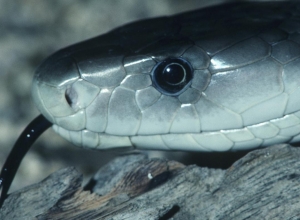Snakebite envenoming, an emergency gone under the radar
If you are like me, chances are that you have never seen a snake in the wild, or maybe just spotted one for a few seconds before it vanishes in the vegetation. Most people are happy about not encountering snakes. In my case, it's a great frustration! I have always been fascinating by this type of elusive species, and memories of my childhood are full of books about strange animals, endemic to some remote places that I dreamt of visiting.
But things would have been different would I have been born in rural areas of Cameroon, or in the Terai region of Nepal, or in Costa Rica. In these snakebite hotspots, snakes are rather avoided at all costs, and the collective memory of the local population usually holds a trail of tragic encountering with venomous snake species. Populations at risk are working barefoot in rice-paddy fields, bare-handedly harvesting wheat or sorghum, cutting firewood, or fleeing conflicts, barefoot and in swamps, marshland, and high grasses. Victims are also adults and children sleeping on the floor, in snake-prone housing, such as mud huts with thatched roofs and cracks in the walls. Often the very precious grain for the family is kept in the same house, attracting rats and mice, the common preys of snakes.
Snakebite mainly affects poor and rural communities in developing countries, where both encounters with venomous snakes are more frequent and access to life-saving healthcare (e.g., antivenom, ventilatory support) is limited or absent. It is estimated that more than 125'000 deaths per year are due to snakebite envenoming globally, with an additional 500'000 severe disabilities (physical and/or psychological). This ranks snakes as the third animal causing the highest number of human deaths on the planet, after mosquitoes (carrying the parasite responsible for malaria) and humans (killing other humans…). Until recently, these staggering numbers of deaths due to snakebite have not received the attention they deserved by the international health community, which pushed "Médecins Sans Frontières/Doctors without Borders" (MSF) to call snakebite "a public health emergency gone under the radar".
Interestingly, there is also a link between snakebite and global environmental changes. Snakebite occurs mainly in places where human activities collide with snake habitats. Deforestation, expansion of agriculture, urbanization and population growth can in many places increase this collision and the probabilities of encountering. It has been shown that climatic changes expected to occur in the Americas over the next 30 years will likely modify the geographic distribution of many venomous snake species, which will cause an overall increase of rural population at risk.
The right snake antivenom administered on time is often the only way to save the life of a bitten person, but many antivenoms are not produced in sufficient quantities, are expensive, and often not adequately distributed in health centers. Moreover, snakebite receives poor attention by pharmaceutical companies, which find it commercially uninteresting to produce antivenom. For instance, the production of one the most effective antivenom against the venoms of African vipers, mambas, and cobras has recently ceased and stockpiles are currently running out.
There is hope, however. After years of advocacy and lobbying by the international community of snakebite experts and public health organizations such as the Global Snakebite Initiative and MSF, the World Health Organization (WHO) has recently taken two very important steps: 1) in 2017 snakebite envenoming was finally admitted back onto their official list of neglected tropical diseases, and 2) during its World Health Assembly in Geneva in May 2018, WHO has adopted a historical resolution calling for immediate and efficient actions against the snakebite crisis. Relayed by some influential personalities (see for example the open letter in "Le Monde" by former UN Secretary General Kofi Annan), these steps will help getting more resources allocated to fighting this public health problem.
The current global momentum around snakebite is very positive, but there is still much more to do. And this is where interdisciplinary research studies can bring some important new knowledge to help tackling this crisis. At University of Geneva, the Institute for Environmental Sciences and the Institute of Global Health have teamed with Geneva University Hospitals to lead the international project SNAKE-BYTE. This project started in March 2018 for four years, funded by the Swiss National Science Foundation, and will seek to understand the incidence of snakebite on humans and animals in Cameroun and Nepal through very large field studies, and with the modelling of geographic accessibility to antivenom and the possible impacts of future environmental changes in these regions. The same team has also participated to two important publications that have given insights about the global burden of snakebite and the role of participatory science:
- Longbottom J, Shearer FM, Devine M, Alcoba G, Chappuis F, Weiss DJ, Ray S, Ray N, Warrell D, Ruiz de Castañeda, RR, Williams DJ, Hay SI and DM Pigott. 2018. Vulnerability to snakebite envenoming: a global mapping of hotspots. The Lancet - https://www.thelancet.com/journals/lancet/article/PIIS0140-6736(18)31224-8/fulltext (See UNIGE's press release, in French)
- Geneviève L, Ray N, Chappuis F, Alcoba G, Mondardini R, Bolon, I and R Ruiz de Castañeda. 2018. Participatory approaches and open data on venomous snakes: A neglected opportunity in the global snakebite crisis? PLoS Neglected Tropical Disease, 12(3): e0006162
Nicolas Ray
Dr. Nicolas Ray is a Senior Lecturer at the Faculty of Medicine, Institute of Global Health, and at the Institute for Environmental Sciences. He is the Co-PI of the SNF SNAKE-BYTE project and the co-director of the global project AccessMod. He was co-directing MapX at UNEP/GRID-Geneva until 2018. He is specialized in geospatial modelling applied to global health and environmental issues, and is currently leading a research group in GeoHealth. In the past few years, he has been involved in many projects and consultancies in Africa to help Ministries of Health and partners to optimize the geographic accessibility to their health networks, through funding by WHO, UNFPA, UNICEF, the Global Fund and the World Bank.



